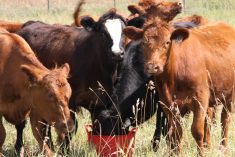Fatter sows producing leaner litters is a match that should enable Canadian farmers to bring home more bacon, say researchers.
Genetic testing has recently created the opportunity to reliably produce leaner pigs in response to consumer demand.
When a boar’s DNA contains the right insulin-like growth factor 2 gene, it passes on an important trait to its offspring – lean muscle mass with a minimum of back fat, said Brian Sullivan, general manager of the Canadian Centre for Swine Improvement.
But sows with the same gene are lean as well. Lean sows don’t have as many litters in their lifetimes as their chubbier counterparts. They also aren’t as fertile, nor do they maintain their condition as well during lactation, Sullivan said.
Read Also

Animal protection delivery to change in Saskatchewan
The Saskatchewan government is looking for a new agency to handle animal welfare after Animal Protection Services of Saskatchewan decided not to renew its contract next year.
Over the past decade, producers have been seeking the market premiums paid for high lean meat content animals with a minimum of back fat. In doing so they have been selecting leaner dams as well as sires.
Producers have found themselves replacing sows sooner as a result, said geneticist Pramod Mathur of the swine improvement centre.
The gene called IGF2 has a genetic imprinting mechanism that means all progeny from a homozygous genotype sire will have the gene, whether or not the dam has it as well. IGF2+/+ or AA carries the lean traits while some sires have an IGF2-/- or GG that produces a fatter animal.
This is because only the favourable alleles from homogeneous sires at the DNAs’ IGF2 locations are expressed in the progeny, meaning that fatter dams can be used to produce offspring that are the leaner market hog.
Blood tests are available through the centre at a cost of about $75 per animal to determine whether a boar has the gene.
A $138,000, the two year research project by the centre will determine if the same tests might ensure that Canadian sows of the IGF2-/-, or fatter genotype, would be more productive than their IGF2 +/+ or IGF2+/- counterparts when bred to IGF2+/+ boars.
Mathur said money from the Alberta Livestock Industry Development Fund and participation of producers from the Lacombe, Alta., based Western Swine Testing Association will see 1,000 sows tested and monitored for two years starting this summer.
“If this results in even a small improvement in litter size and producers getting more litters from each sow in her lifetime, then it returns more from production and saves farmers money in replacements.
“It puts money in farmers’ pockets then. That is when $138,000 doesn’t seem like much of a cost for something that benefits an entire industry,” said Mathur.
He said the project will report interim results if the research points to IGF2-/- sows creating savings for the industry. A final report is expected by June 2008.














